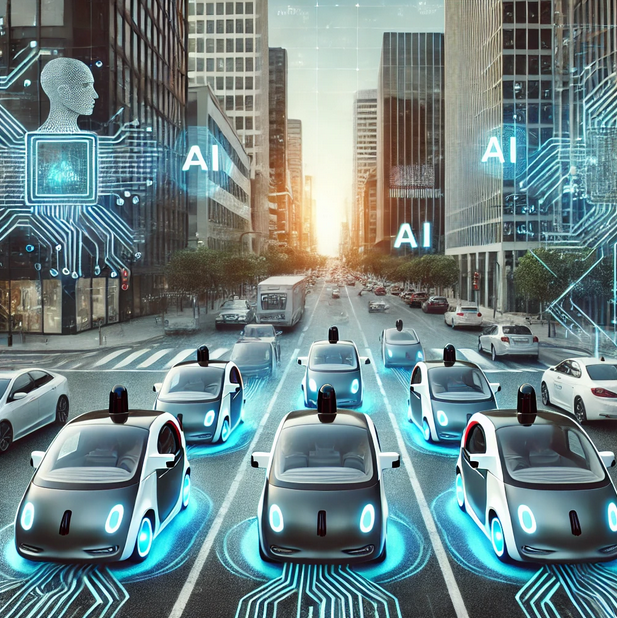(GOOG), (UBER), (TSLA), (INTC), (BIDU), (QCOM)
Remember KITT, that chatty Trans Am from Knight Rider? Well, folks, the future has arrived, and it's a lot less mouthy but infinitely more impressive.
It's 2024, and while we're still not quite zooming around in flying cars, we've got the next best thing: robotaxis.
After years of hype that made even crypto evangelists look restrained, autonomous driving has finally hit the streets. And let me tell you, it's not just hitting the streets - it's taking them over faster than a trader jumps on a hot tip.
Waymo, Alphabet's (GOOGL) golden child, is now shuttling around 100,000 passengers a week. That's more people than I've seen at a Bitcoin conference, and trust me, I've been to a few.
Meanwhile, Uber's (UBER) decided to play nice and partner up, probably realizing it's better to join the revolution than be run over by it.
But the real showstopper? Elon Musk is about to unveil Tesla's (TSLA) robotaxi next month. Now, I've seen Musk pull rabbits out of hats before, but this might just be his Mary Poppins moment - pulling a whole taxi service out of that electric hat of his.
Now, don't go thinking this is just a two-horse race. The robotaxi arena is getting more crowded than a Wall Street bar on bonus day.
Intel's (INTC) Mobileye is flexing its AI muscles in the driver assistance space. And over in China, Baidu's (BIDU) Apollo project is moving faster than a chopstick at a dim sum feast.
With China's massive market and their government's love affair with AI, Baidu could be sitting on a gold mine.
Meanwhile, Qualcomm (QCOM) is quietly becoming the backbone of this whole operation. They're making sure these AI cars stay connected better than a broker to his Bloomberg terminal. Trust me, in this game, connectivity isn't just important - it's everything.
And just when you thought the party couldn't get any livelier, in walks a whole new crowd of players.
Cruise Automation, AutoX, Argo AI, Pony.AI - they're all elbowing their way to the robotaxi buffet. This isn't just competition; it's a full-blown innovation arms race.
Now, let's talk numbers, because that's where things get really interesting. The robotaxi market is projected to grow at a CAGR of 66.3% from 2023 to 2029.
To put that in perspective, that's faster growth than my cholesterol levels after a week in Tokyo's finest sushi bars. We're looking at a market size of $34.1 billion by 2029.
But here's where it gets more interesting - by 2031, we're talking about a market worth $118.61 billion. That's the kind of growth that makes tech bubbles look like a kid's balloon party.
Now, why should you care? Well, unless you enjoy spending 216 hours a year staring at brake lights (that's how much time the average American wastes in traffic), this revolution is for you.
These AI-powered taxis promise to be 80% cheaper than owning a car. That's basically like getting a Bentley for the price of a bicycle, minus the sweating.
And Waymo's not messing around. They've doubled their weekly rides from 50,000 to 100,000 faster than you can say "autonomous vehicle."
They're expanding quicker than expected, with Phoenix, San Francisco, Los Angeles, and Austin all on the plans of expansion in the coming months.
So what does it mean for us? Well, this robotaxi market is projected to be worth $5 trillion. That's not just big - that's "make Jeff Bezos look like he's running a lemonade stand" big.
Of course, it's not all smooth driving. Each of Waymo's cars costs about $100,000. That's a lot of zeros, even for Alphabet. Still, they're betting big, planning to pour another $5 billion into Waymo.
Clearly, they think this goose will lay golden eggs, not just waddle around eating their cash.
Tesla, never one to be left in the dust, is taking a different road. Their robotaxis are all cameras and AI, no lidar or radar.
It's like they're bringing a smartphone to a laser gun fight, but knowing Musk, that smartphone probably shoots lasers too.
The bottom line? The robotaxi revolution isn't coming - it's here, and it's moving faster than anyone could have anticipated.
This isn't just about cool tech or convenient rides anymore. It's about a $5 trillion market opportunity that's revving its engine right in front of us.
As for KITT? He was cool back in the day, but compared to the AI revolution happening now, he's firmly in the rearview mirror.
After all, it’s not the talking car that’s changing the game—it’s the AI under the hood.


